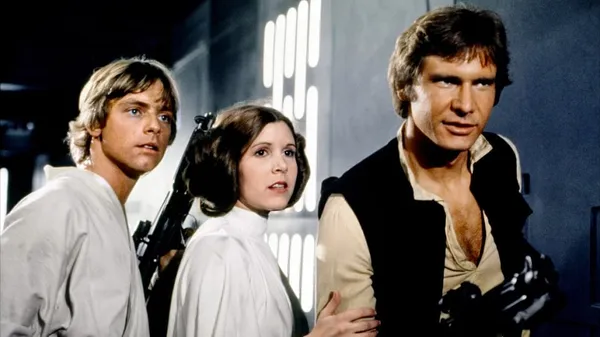Eye For Film >> Movies >> Star Wars: Episode 4 - A New Hope (1977) Film Review
Star Wars: Episode 4 - A New Hope
Reviewed by: Scott Macdonald

One question that I keep asking myself is "Why is Star Wars so adored the world over?" It is quite possibly the single most startlingly hollow story that ever made $500m-plus at the box-office. I admire its storytelling purity, its skill in mining excitement in a clever way, and its sheer entertainment value.
As critic Jonathan Rosenbaum correctly notes, "None of these characters has any depth", I counter with the idea that we supply much of the depth and mythos ourselves, and that the journey is what gives us a chance to invest ourselves. We transpose the best parts of our own personalities into the characters, and go along with them on the quest. Especially with Lucas' glorious blend of mythological heroes and villains, good and evil, told in a straightforward manner with dazzling visual design. Lucas hides in plain sight the world the characters inhabit is as important to him as the ongoing plot mechanics.

In a stunning opening shot, the Empire chases Rebellion forces in their mighty warships far above the planet Tatooine. The Rebellion has stolen plans for the Death Star, an armoured space station with a planet-destroying weapon at its heart. A Rebel leader, Princess Leia (A spunky Carrie Fisher) sends a pair of mismatched droids on a secret mission to deliver the stolen plans. A young Tatooine native farm boy, Luke Skywalker, obtains the pair through dealings. Inevitably, Skywalker takes the hero's quest to save Leia and deliver the plans. He is aided by wily old Jedi Knight Obi-Wan Kenobi (Alec Guinness), cynical space pirate/smuggler Han Solo (Harrison Ford) and "walking carpet" Chewbacca.
The characters of Star Wars follow the familiar archetypes of myths and lore, but each of them is clearly delineated. This borrowing of familiar material is common throughout cinematic and literary history - and Lucas is an apt pupil of Joseph Campbell.
Lucas nods to Akira Kurosawa, from his samurai classic The Hidden Fortress; choosing to tell the story from the least important characters point of view works well, introducing us from an outsider's perspective to our heroes and their missions. Lucas endears the quibbling droids to us and keeps the story on a smaller scale for the first half of the film. The plot moves at breakneck speed once everything is established - Just compare the opening 30 minutes of Star Wars with the first hour of Attack of the Clones to see just how tight and clever the editing is. The action is well paced and exciting, and marries well with John Williams magisterial and uplifting score. A glorious mixture of leitmotif - playing various themes and character motifs in different tempos, keys, and using different instruments to accentuate the onscreen action and mood - and bold accompaniment won Williams his third Oscar for Musical Score.
Enormous strides in film technology, and the ability to realise red-blooded fantasy, is Star Wars' true calling. Especially when blended with a story that is as affirming. It was a stunning kick up the backside to science fiction and fantasy films of the past 27 years, inspiring filmmakers and opening many doors for other established entertainers. Sure, there has been a lot of uninteresting bubblegum cinema because of Star Wars' success, and Hollywood's desire to repeat the profitable formula.
It was not just an enormous success, but it changed much of the focus of filmmaking, for either better or worse. You decide that, but few can deny the great storytelling of Lucas' true first episode of his space-opera.
Reviewed on: 04 May 2005


















